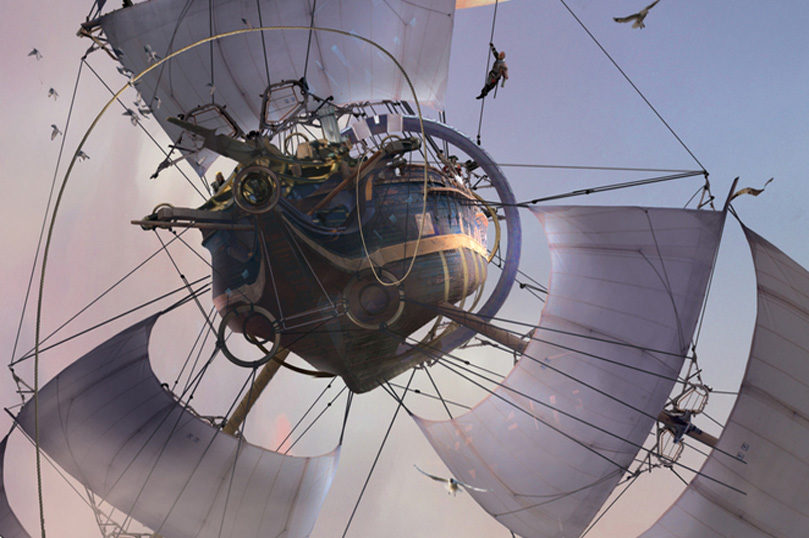 Written by David D. Levine
Written by David D. Levine
My novel, Arabella of Mars, takes place in an alternate 1814 in which the solar system is full of air and you can travel to other planets by sailing ship. How could this possibly work? I spent a lot of time during the development of the book working out how interplanetary travel might be accomplished using the technology of the Napoleonic Wars.
The first challenge is getting into orbit from the Earth’s surface. Given that the atmosphere extends into space, you can do this with a hot-air balloon—but, without propane or similar high-energy-density fuels, it would be difficult to carry enough fuel. I worked around this by giving the ship a boost of exceptionally hot air from ground-based furnaces, which is then kept warm with coal for the rest of the ascent. Eventually you reach orbit, where you are in a state of “free descent,” and you can deflate and fold the balloon envelopes.
Once you’re in orbit, how do you navigate? Despite pictures you may have seen of fanciful 19th-century airships, there’s no point in putting sails on a lighter-than-air craft. A balloon is, in effect, a giant sail already: it moves with the wind. Adding more sails doesn’t change that appreciably, nor would sails allow you to change course or speed. The only reason a sailing ship of the sea can travel in a direction other than with the wind is that it has a keel, embedded in a different medium.
Furthermore, if space is full of air, there would be a general flow of wind due to the Earth’s motion around the sun… and when I say “general flow of wind” I mean a planet-scouring gale, because the Earth’s orbital speed is 67,062 miles per hour. To avoid this, Mary Robinette Kowal suggested that the interplanetary atmosphere (which she called the “cosmic tide”) moves around the sun at the same speed as the planets, while each planet’s atmosphere moves at the planet’s own rotational speed. This implies some really complex and nasty weather where the two atmospheres grind against each other, an area which I eventually named “the Horn.”
After considerable thought and discussion with like-minded geeks, I decided that the complexity of the weather at the Horn was the key to navigation. Once in this zone of chaotic winds, you simply find an air current that is going in the direction you want and put yourself into it. To move the ship from one current to another I invented “propulsive sails,” or “pulsers”—a pusher propeller of wood and canvas, built like a Greek windmill, driven by the crew using bicycle-like pedals. In this world you can always tell an aerial sailor by his enormous calves and thighs.
So once you are in orbit, you strike all sails to reduce air resistance (except for the fore-and-aft sails—spinnakers and spankers—which are used for steering and to keep the ship from spinning counter to the rotating pulsers), pedal into a favorable air current, then set all sails to catch that wind. Then you can simply drift with the current until the next course change.
Of course, when you are floating in midair in free fall, you have the problem of figuring out where you are and how to get where you are going…but that’s a topic for another essay.
Follow David D. Levine on Twitter, on Facebook, and on his website.













Hey David, It sounds like you worked it out pretty well in your story “The Wreck of the Mars Adventure” in the “Old Mars” anthology which uses some the same techniques. Good story BTW, assuming of course that there is a breathable atmosphere is the solar system which could be remotely explained by some rare astrophysical/alternate dimensional mcguffinry.
This is so full of errors and misunderstandings that I cannot even begin to explain why. If you think “geeks” were helping you, then they fail to merit the term geek.
Forget the silly rationalizations and focus on your storytelling.
Presumably a solar system full of atmosphere would mean radically different weather patterns for Earth, right? What effect would/does that have?
Somebody in the 18th Century actually wrote a story along those same lines, using vacuum balloons (known to be a theoretical possibility long before the actual first manned balloon flight with hot air) and using that empty space was filled with something that made balloons practicable. The one insuperable problem was the sheer size of the solar system — even at its closest, Mars is at least 35 million miles away, and it was hard to imagine how that distance could be crossed in anything like a human lifetime. The author fudged with a time dilation effect, making the journey seem shorter for the voyagers than it was in real time, but you could tell he was just waving his hand to get around something even he couldn’t figure out how to accomplish.
https://www.amazon.com/Speedy-Journey-Eberhard-Christian-Kindermann/dp/1494212420/ref=sr_1_1?s=books&ie=UTF8&qid=1467956259&sr=1-1